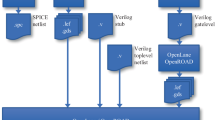Abstract
The purpose of a communication system is to transmit an information-bearing message signal through a channel that separates a transmitter from a receiver. The modulated carrier is often induced and interfered with by various noise sources. The co-channel separation system is a demodulation process function that operates at the same carrier modulation system. Here, we adopted the field-programmable gate array (FPGA) design platform configuration to develop, implement and achieve co-channel separation for an amplitude-locked loop demodulation chip-design digital system with additive white Gaussian noise interference. In this paper, the compact reconfigurable I/O built-in FPGA chip system is integrated and applied to obtain the cross-field relevant integration function for communication and chip-design system via programming in a graphical language. Additionally, the FPGA chip-design system runs all of the program code in hardware and provides high reliability and determinism. This cross-field ideal is adopted to save time and reduce complexity in the design development of a custom circuitry system. The FPGA chip-design system described in this paper is also used to achieve a digital communication chip prototype design model, followed by presentation of the steps necessary for building and program verification. The communication and chip-design concept may provide very useful physical applications for the industry.







































Similar content being viewed by others
References
Pettigrew, A. M. (1996). The amplitude-locked loop, the theory and operation of the FM 201/5 high performance FM demodulator, Ampsys Company Document.
Xilinx Inc. (2009). Virtex-5 platform FPGAs: Virtex-5 FPGA data sheet.
Kehtarnavaz, N. (2008). Digital signal processing system design: LabVIEW-based hybrid programming (2nd ed.). Amsterdam: Elsevier.
National Instruments Inc. (August 2008). Getting started with Compact-RIO and LabVIEW.
Haykin, S. (2001). Communication systems (4th ed.). New York: Wiley.
Jong, G.-J., & Horng, G.-J. (2011). The improvement of all-digital amplitude-locked loop separation analysis combined MIMO system. International Journal of Innovative Computing, Information and Control, 7(3), 1001–1015.
Theodore, S. (1999). Rappaport, wireless communications: principles and practice. USA: Prentice Hall.
Moir, T. J. (1995). Analysis of an amplitude-locked loop. Electronics Letters, 31(9), 694–695.
Jong, G. J., & Moir, T. J. (1998). The performance of the amplitude-locked loop with co-channel interference. In Proceedings of the IECON ’98, Aachen, Germany.
Jong, G. J., Moir, T. J., & Pettigrew, A. M. (1999). The high performance FM demodulator using the amplitude-locked loop with co-channel interference. In International symposium on communication (ISCOM) (pp. 284–288), Kaohsiung, Taiwan.
Jong, G. J., Moir, T. J., Pettigrew, A. M., & Su, T. J. (1999). Improvement of FM demodulator with co-channel FM interference. Electronics Letters, 35(20), 1758–1759.
Wu, G. K., & Feher, K. (1992). The impact of delay spread on multilevel FM systems in a rayleigh fading, CCI and AWGN environment. In 1992 IEEE 42nd Vehicular Technology Conference (Vol. 1, pp. 528–531).
National Instruments Inc. (2004). NI Compact-RIO—Reconfigurable control and acquisition system.
National Instruments Inc. (2009). Compact-RIO developers guide-section one: LabVIEW architectures for control.
National Instruments Inc. (2009). Compact-RIO developers guide-section three: Customizing hardware through LabVIEW FPGA.
National Instruments Inc. (2009). Compact-RIO developers guide-section two: Adding communications, expansion I/O and machine vision.
Kuo, S. M., & Gan, W.-S. (2004). Digital signal processors: Architectures, implementations, and applications (2nd ed.). Englewood Cliffs: Prentice Hall.
Oshana, R. (2006). DSP software development techniques for embedded and real-time systems (Embedded Technology) (pp. 81–94).
Best, R. E. (1997). Phase-locked loops: Design, simulation, and applications (4th ed.). USA: McGraw-Hill.
National Instruments Inc. (2009). NI-RIO 3.2.1 known issues.
Xilinx Inc. (2008). UG190 Virtex-5 FPGA user guide, UG190 (v 5.3).
National Instruments Inc. (2009). Compact-RIO developers guide-section four: Creating a networked user interface.
National Instruments Inc. (2009). Compact-RIO developers guide-section five: Deploying and replicating systems.
Durand, C., Boutros, J., & Bejjani, E. (2000). Forward error correction of FSK alphabets for noncoherent transmission over AWGN channel. IEEE Communications Letters, 4(10), 318–320.
Author information
Authors and Affiliations
Corresponding author
Rights and permissions
About this article
Cite this article
Jong, GJ., Chen, YC., Huang, CS. et al. The Implementation of an Amplitude-Locked Loop for Digital Communication Chip Design. Wireless Pers Commun 72, 2773–2801 (2013). https://doi.org/10.1007/s11277-013-1180-2
Published:
Issue Date:
DOI: https://doi.org/10.1007/s11277-013-1180-2




